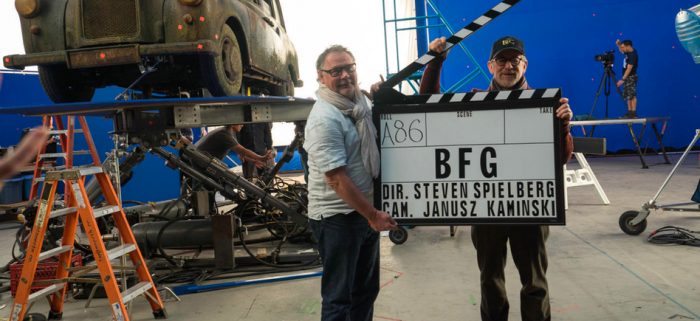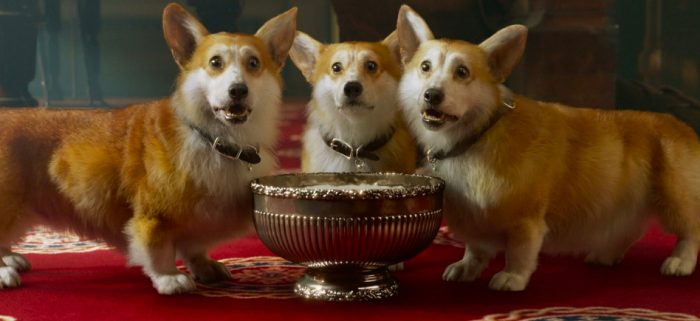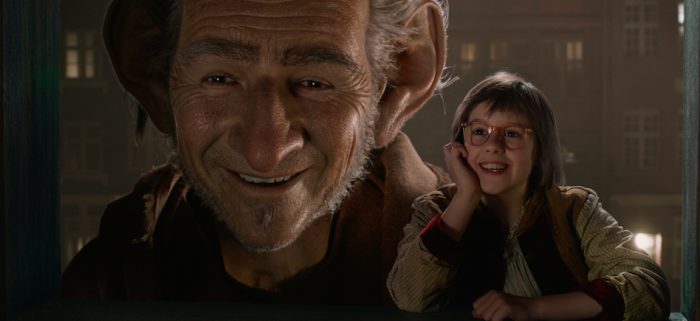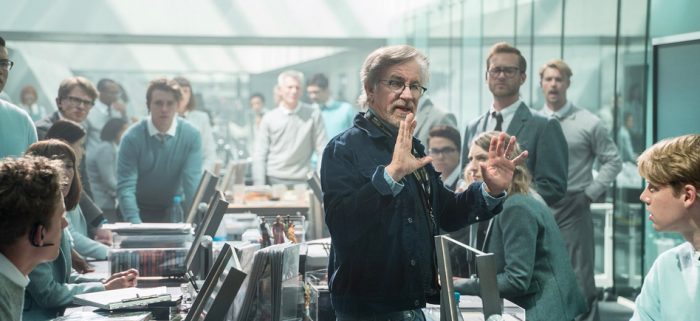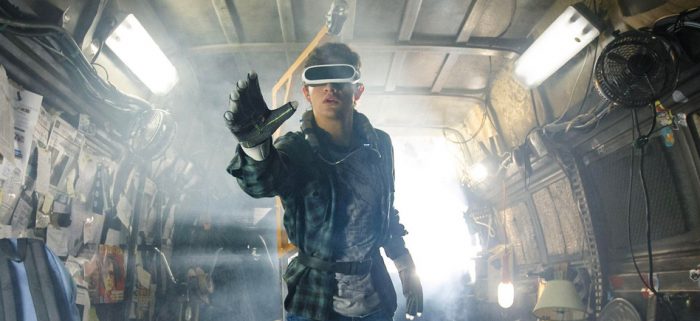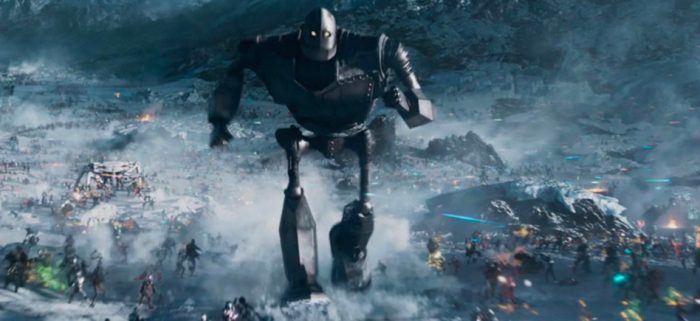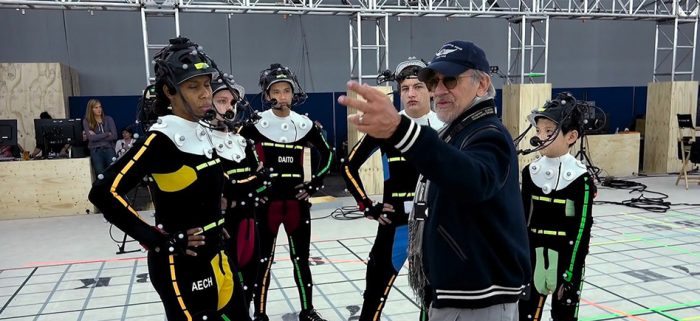21st Century Spielberg Podcast: With 'The BFG' And 'Ready Player One', Steven Spielberg Attempted To Return To His Roots, With Mixed Results
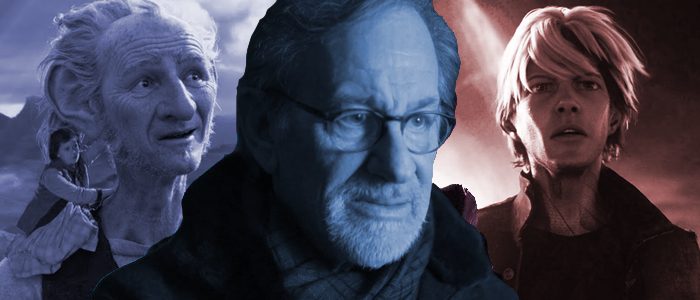 (Welcome to 21st Century Spielberg, an ongoing column and podcast that examines the challenging, sometimes misunderstood 21st-century filmography of one of our greatest living filmmakers, Steven Spielberg. In this edition: The BFG and Ready Player One.)
(Welcome to 21st Century Spielberg, an ongoing column and podcast that examines the challenging, sometimes misunderstood 21st-century filmography of one of our greatest living filmmakers, Steven Spielberg. In this edition: The BFG and Ready Player One.)
What do you think of when you think of a Steven Spielberg movie? There are a variety of answers, but "blockbuster" tends to be at the top of the list. After all, it was Spielberg's Jaws that gave birth to the idea of the summer blockbuster, and ever since then, he's been riding that high. Steven Spielberg is a man who makes big movies. Big spectacles. Big special effects. Big emotions. Everything is big, big, big. And yet, in the 21st century, Spielberg adapted. He entered the new century riding high off of finally scoring multiple Oscars for titles like Schindler's List and Saving Private Ryan.
After decades of being thought of as nothing more than a creator of harmless pop entertainment who made oodles of money, it could no longer be denied that Steven Spielberg was a real artist. And he parlayed that into the films he would make in the 2000s. He kicked things off with the special-effects heavy A.I. and Minority Report, but after that, he would begin turning out smaller things. Well, smaller for Spielberg, at least. He was crafting historical dramas and character-driven stories. He was showing us all that he had more on his mind than T-Rexes and killer sharks.
Now and again he would return to his roots, bringing back Indiana Jones for Kingdom of the Crystal Skull, and finally making the Tin Tin movie he had been dreaming about for years. But mostly, Spielberg seemed content to try new things. And then something happened. He got that old itch to entertain. To summon up a spectacle. To fire up as much digital effects trickery as he could manage and forge entire digital worlds where nothing is real. It was nothing he couldn't handle, right? Steven Spielberg is a filmmaker who knows all about technological advances in movies just as he knows all about crafting big, loud, popcorn entertainment. In other words, he knows how to give the audience what they want. As Robert Kolker wrote in A Cinema of Loneliness, "The frequency, success, and influence of [Spielberg's] films over three decades have made them a kind of encyclopedia of desire, a locus of representations into which audiences wished to be called."
With effects-heavy titles The BFG and Ready Player One, Steven Spielberg was coming home. He was returning to his roots. He was giving the audience what they wanted. What could go wrong?
Dreaming For a Living
Loneliness is something on display in many a Steven Spielberg film. His child characters are lonely. His adult characters are lonely. His fantastical creatures can be lonely, too. Sometimes the loneliness is self-inflicted – characters will push others away out of fear, or discomfort. But overall, the worlds of Steven Spielberg can be lonely places.
By all accounts, Steven Spielberg was a lonely kid. And that loneliness didn't just go away when he got older. "Loneliness is a place that is familiar to me, and a place that I always try to escape from," he said. "I sometimes just have to fill my own life with enough dreams so that I can pretend that I'm not lonely." Dreams are Spielberg's escape from all that loneliness. "I don't dream at night, I dream at day, I dream all day; I'm dreaming for a living," he said once.
With all of that in mind, it's easy to see what drew him to The BFG, his first real honest-to-gosh Disney movie (he had made movies for the Disney distribution label Touchstone Pictures, but never an actual movie with the official Disney logo proudly proceeding the picture). The BFG is a story about both loneliness and dreams. The titular BFG – the Big Friendly Giant – has a job bottling up dreams and unleashing them on the public. But it wasn't the BFG that Spielberg related to in this story. It was Sophie, the 10-year-old orphan who becomes the BFG's unlikely companion. "I related to Sophie, pretty much throughout the whole story," the filmmaker said. "Sophie was my spiritual guide through the process of telling this story."
And yet, in a completely separate interview, Spielberg offered a conflicting take. "It was very easy to tell The BFG's story, because I came from the same place that he came from," he said. "I didn't have the feistiness or the tenacity of the character of Sophie, who is able to tell off a 25-foot-tall giant, but it's a great theme in Dahl's story too because, in a sense, there are two orphans in this story. The BFG is orphaned from his brothers, just by the fact that they're all bullies. They abuse him and take advantage of him, and Sophie is the unfortunate orphan of bad circumstances. So when these two orphans meet, they form a life together. That's the core essence of the film. I remember what it was like to really feel isolated and alone; I was that way when I was younger before having children, and before getting married...before all of that."
As The BFG begins, we're introduced to Sophie (Ruby Barnhill), an orphan who wanders around her orphanage late at night, unable to sleep. Like most lonely people, she's fond of talking to herself, and pouring over the pages of books, using them as a kind of doorway to another, less lonely world. But she's soon thrust into a real unordinary world when she happens to spot a 25-foot-tall giant, played by Mark Rylance, stalking the streets of London. The giant spots her, too, and whisks her away. It's a little risky to start off your sweet family film with a kidnapping, but so it goes.
These opening scenes allow Spielberg to blend the real with the unreal – Rylance's BFG is a performance-capture creation, entirely digital and yet somehow able to convey Rylance's actual performance. In his review of the film for RogerEbert.com, critic Matt Zoller Seitz called Rylance's work here "the first motion-capture performance to equal Andy Serkis' best" in the Lord of the Rings trilogy, and he's not wrong. Rylance's warmth comes through this fantastical character, and a lot of work went into getting the eyes right – they look like Rylance's own eyes. There's no uncanny valley here. When shooting Rylance's performance, Spielberg and company relied on a two-story scaffolding structure where the actor could stand with a performance-capture camera directly in front of his face to capture that genuine eye contact. It works, and it works exceedingly well.
Not only is Spielberg able to help bring fully-realized digital characters into the world here, but he's also able to have fun. When the BFG whisks Sophie away, Spielberg's camera is constantly on the move, whizzing through the dark London streets as the BFG uses an impossibly large cloak to cleverly hide from prying eyes.
Eventually, Sophie and the BFG end up back in Giant Country, where, as the name suggests, there's more than one giant lurking about. And unfortunately, while the BFG is ultimately a nice guy, the giants around him – all of whom are much, much bigger – are bullying cannibals who would eat Sophie up if they discovered she was in their world.
And then, uh, not much happens.
Reunions and Fart Jokes
The BFG reunited Spielberg with screenwriter Melissa Mathison, who penned one of the filmmaker's finest works, E.T. the Extra-Terrestrial. The idea of Spielberg and Mathison reteaming for another family-friendly adventure sounds too good to ignore, and much of the press material for the film played up the Spielberg/Mathison connection. "Melissa was there on the E.T. set every day, and every day on The BFG," Spielberg said. "So I've been very fortunate to bookend our relationship with two stories that came from her heart."
But Mathison had a problem: there just wasn't much story to be told. "In a strange way, not much happens in the book because it really is about their relationship," Mathison said. "There's no dramatic drive to it. Their decision to try and get rid of the giants happens pretty easily and quickly, and there was an episodic quality to the chapters. It wasn't as story-driven, so we needed to create a narrative."
And yet, Mathison's script remains surprisingly faithful to the Roald Dahl book that inspired it. And that's the problem – it's too faithful. The script pads things out with extended action sequences, but the narrative here is painfully light. Perhaps that's a feature, not a bug – it's a whistful little fairy tale, after all. But Spielberg is trying to fill up 117 minutes here, and the lack of story hurts things considerably.
Eventually, a vague plot thread takes form, where Sophie and the BFG turn to the Queen of England to help get rid of the bad giants. It's silly, and that's okay – Spielberg leans into the silliness. He even creates his first big-screen fart joke, and it's dynamite. Humor based on flatulence is crude, and often bottom-of-the-barrel stuff. But Spielberg, ever the pro, isn't going for a cheap laugh here. No, he makes sure to create an elaborate, multi-tiered fart joke. After the BFG meets the queen he offers her, her staff, and a group of military men who have been called in to help with the bad giants a drink of "frobscottle," a carbonated green drink with bubbles that run down instead of up. Everyone drinks up and sure enough, it launches multiple gass-passings – the Queen's butler farts and blows down a breakfast cart; the Queen farts and causes a tablecloth to billow; the military men fart and are launched into the air as if they had jetpacks; even the Queen's Corgis get in on the action, farting their way out of the room as if propelled by a great wind (which I guess they are, technically speaking). It's not so much that there's farting going on here that makes this scene hilarious; it's the way Spielberg builds it up, with everyone downing their drinks and then slowly raising their heads, eyes widening, as they realize what's about to happen.
But the movie isn't just fart jokes. It's also lovely little moments like when the BFG shows Sophie how he catches dreams – dreams being represented by flitting, flying bursts of color that the BFG can capture in jars like butterflies. He then takes Sophie out into civilization and literally gives the dreams to other people. Like Spielberg, the BFG's entire occupation is about delivering dreams; flights of fancy that can take the dreamer to unexpected, wonderful places. But there are also bad dreams lurking about, and there's a real melancholy blanketing The BFG. The giant is still haunted by the fact that he once had a human child companion like Sophie in the past – and his fellow giants ended up eating the kid. That's dark stuff, and it's to Spielberg and Mathison's credit that they don't shy away from that darkness.
Sadly, this would be the final collaboration between filmmaker and screenwriter. Mathison died in 2015, a year before the film was released. "I have not had a chance to mourn Melissa," Spielberg said, "because she's been so vibrant and real to me, in the cutting room, on the scoring stage, in the dubbing room — she's just always been there with me, so because of that, it's going to be hard when I have to let The BFG go, because then I have to let Melissa go, too."
Escape Into the World of Dreams
As a technical exercise, The BFG is a success. Spielberg has become famous for embracing cinematic technology, and this is no exception. The secret seems to be finding ways to treat the new like the old and find familiar ground. For The BFG, Spielberg first gathered his creative team and a group of production assistants in his garage (and remember, this is Steven Spielberg we're talking about, so it was probably a bigger-than-normal garage) and there he blocked the entire film using the PAs as actor stand-ins.
"It became my prototype for the film and helped me to realize the story and determine the best way to tell the story," Spielberg said. "It was one of the most valuable rehearsal exercises I have ever put myself through, and it helped me to understand the deepest, deepest DNA of the story." And it shows: for all the digital trickery on display here, none of it ever distracts. It's not exactly realistic, but it doesn't have to be – it's a fantasy, after all. And all of those giants have real weight when they move about, just as much weight as any dinosaur lumbering around Jurassic Park. Spielberg also worked with longtime cinematographer Janusz Kaminski again, and Kaminski was in charge of lighting both the physical sets and the virtual sets to make sure it all looked evenly balanced.
And it all looks so lovely. The way the BFG blocks out a streetlamp with his hand to hide in the shadows; the way the BFG and Sophie jump into a body of water and emerge in its reflection; the over-the-top scene where the BFG dines with the Queen, sitting down at a make-shift table and using a grand piano as a seat while using a rake and shovel as a fork and spoon; the interior of the BFG's house-cave, where he sleeps in a bed made from a boat. It's all so whimsical, and Rylance and Barnhill (who, oddly enough, hasn't done a live-action film since this) are perfect together.
Sadly, all of that only goes so far, and ultimately, The BFG is sleight. It's Spielberg at his lightest, and while that's not entirely a bad thing, E.T. this is not. It's hard to imagine anyone revisiting this the way they revisit E.T. It's a fun, amusing, sweet little film that tends to slip out of your mind the minute it ends, like a dream that collapses the minute you open your eyes. And audiences just didn't seem to care – it was a rare box office bomb for Spielberg.
But it also enabled Spielberg to embrace the fantastical again. "I think the number of historical movies that I've been making — films like Lincoln, Bridge of Spies, and then going further back to films like Amistad and Schindler's List — have kept me fettered to the accuracy of telling a historical story," Spielberg said. "So being able to escape into the world of dreams and imaginations has been a dream in itself. That makes The BFG special, because it was my escape into what I think I kind of do best, which is just let my imagination run away with itself."
And he wasn't done yet. He still had another fantastical world to escape to. It would result in a huge box office hit – and one of his worst movies.
A Creator Who Hates His Own Creation
Does Steven Spielberg regret his career? That sounds like a stupid question – he's world-famous, incredibly wealthy, and wields the type of power other filmmakers can only dream of. And yet...there has always been a kind of shadow hanging over Spielberg's worth. Audiences may embrace what he does, but critics haven't always been so kind. Many were ready to write Spielberg off as a fad even as Jaws was blowing up the box office. And for most of his career, there's been the sense that the filmmaker has been chasing legitimacy – longing to be seen as a real artist, not just the creator of forgettable fluff. Remember: this is the guy who hired a film crew to film him watching the 48th Academy Awards nominations being announced, so sure that he would score himself a Best Director nod (he didn't).
So much of Spielberg's 21st-century work was devoted to bucking tradition and trying new things. He had finally proven himself as a serious artist, and yet...all anyone seemed to want was another Jurassic Park. Another Jaws. Another E.T. One can easily imagine Spielberg's frustration – he fought so hard to prove he could make serious movies for serious people, but all his fans wanted was more spectacle. And that brings us to Ready Player One, arguably the worst film Spielberg has ever made.
The marketing for Ready Player One was all about how Steven Spielberg was returning to the world of big, loud, effects-driven movies. The guy who invented the blockbuster was finally making a blockbuster again. And not just any blockbuster, oh no – it was a blockbuster about nostalgia. And not just any nostalgia! But nostalgia for the 1980s, the era where Spielberg started to become his most-powerful. The story is as much a tribute to Amblin Entertainment as it is '80s pop culture as a whole.
"I love huge, great adventure stories," Spielberg said when promoting the flick. "I haven't made an adventure movie in a long time, a movie that is basically for the audience, not so much for me as much as it is me wanting to give the audience everything they want and perhaps more." Spielberg raised eyebrows when, during Ready Player One's premiere at SXSW, he said that this wasn't going to be a film – it was a movie. The implication was clear: films are for art snobs, movies are for everyone. This was going to be Steven Spielberg's big comeback! A return to populist filmmaking! Er, make that moviemaking.
"I just put my audience hat on when I made this film," the director said. "I had a blast going back to those years when I was making films just for audiences. Then, always saying what would the audience want? What surprise would the audience like at this moment? How can the audience be ahead of us until they're no longer [ahead], and then we're ahead of them, and play that leapfrog with an audience? I hadn't been in that kind of arena for years. That's why I enjoyed the process so much."
If Spielberg really did enjoy working on Ready Player One, it doesn't show in the finished film – a loud, cold, messy blitz where everything is fake. The only scene that works comes at the end, when all the pop culture regurgitation has stopped, and a lonely artist – Mark Rylance playing video game genius James Halliday – admits that he always had trouble fitting into the real world. That he was a lonely guy who found escape in dreams – noticing a recurring theme here? – only to realize in the end that as much as you might want to, you can't spend your entire life in a dream. You need to come back to reality.
It's a haunting message and it's easy to see Spielberg in Halliday – a man who built up an entire pop culture universe only to see it grow beyond his control and become something crass. Once upon a time, Steven Spielberg was part of the movie brat generation that came rolling into Hollywood and blew up the studio system. His colleagues like Francis Ford Coppola, Brian De Palma, and John Milius were trying to make films that were subversive; films that bucked the norms. But Spielberg was the opposite. He was an old school Hollywood guy, and what he wanted to do was take the tricks he learned from old masters like William Wyler, Victor Fleming, Frank Capra, and so on, and repurpose it all through an exciting new lens.
The results gave birth to the blockbuster as we knew it, and a curious thing happened – Hollywood, not always open to change, embraced what Spielberg was selling. He was a moneymaker, and his big spectacle films – along with those of his buddy George Lucas – were what made that money. One can draw a clear line from what Spielberg did at the start of his career to the current film landscape we're in now, where smaller, adult-driven films barely get play and studios want more and more superhero stories. Films with $300 million budgets that have to blow the roof off the box office or be deemed failures. And now, with Ready Player One, Spielberg was returning to the blockbuster and perhaps asking – what have I done?
Desperately Seeking Escape
Adapted from the popular novel by Ernest Cline, Ready Player One is set in 2045, after events like "the corn syrup droughts" and the "bandwidth riots," according to our narrator, the painfully boring Wade Watts, played by a painfully boring Tye Sheridan. The most inert of all of Spielberg's protagonists, Wade is uninteresting and lacking an arc – he learns absolutely nothing throughout the entire film. He starts and ends the film loving video games, and the only thing that's changed is he goes from a poor kid to an obscenely wealthy kid. Oh and he gets a girlfriend. Wow, cool.
In the future, life has gotten so shitty that everyone escapes to the OASIS (Ontologically Anthropocentric Sensory Immersive Simulation), a vast virtual reality choked with pop culture references. A lot of those references are from the 1980s, the favorite decade of now-deceased OASIS creator James Halliday. But there's plenty of other stuff, too, from films, TV shows, and video games of the 1990s and beyond. Basically, nothing before the 1980s exists in the OASIS, but everything from that decade and beyond is represented via flashy special effects.
Cline's book was loaded with references to Spielberg's own films, and when Spielberg took the director's gig he made a big deal about removing as much Spielbergian nostalgia as he could. "When I was first given the script by Warner Bros., I said, if I determine to take the leap, I'm going to have to cut out at least 70 percent of my own cultural references," he said. "Because otherwise it's going to be like primping in front of a mirror, and I'm just not going to let myself do that. I pride myself on my modesty. But I was part of the '80s and I know that. I'm objective enough about my own work and about the past to know that it would be a sin to cut out the DeLorean [from Back to the Future, which Spielberg produced] and the T. Rex [from Jurassic Park] and maybe a few other things that came from my movies. So I left about 20 percent of them in from the book."
Not only is the OASIS full of references to everything from Buckaroo Banzai to The Iron Giant, but it's also home to a massive game that no one has been able to beat. Before Halliday died he hid a golden Easter Egg somewhere within the OASIS, and a bunch of clues to find it. In a Willy Wonka-like scenario, whomever eventually finds the Easter Egg will become the rightful, legal owner of the OASIS. And because Wade is our boring hero, he wants that prize, damn it!
Wade isn't the only one after the Egg. There's a whole bunch of players who want in, and they call themselves Gunters, like Easter Egg Hunters. And if you think that's eye-rollingly bad, don't worry – all of the characters say "Gunter" a lot in this movie. In the video game world, Wade goes by the avatar Parzival, who looks kind of like an alien who just discovered emo music. It's an odd choice – you can look like anything and anyone in the OASIS, but this wispy blue-skinned figure with severe bangs is what Wade wanted.
In his quest for the Egg, Wade meets Art3mis (Olivia Cooke), and it's only a matter of time before Wade is head over heels in love with her. There's an interesting idea here – Wade doesn't meet the real Art3mis (who is revealed to be named Samantha Cook) until late in the movie. So, is he in love with the real Samantha or her avatar? Or is there really no difference? The movie dances around this idea and then forgets about it because there's just no time – we have to get to all the action.
While Wade, Samantha, and Wade's friends' quest for the Egg is seen as pure and noble – because they're true gamers, after all – there's another party jockeying for control. It's the evil Innovative Online Industries (IOI), run by the evil Nolan Sorrento, played by fantastic actor Ben Mendelsohn, who is oddly saddled with weird, distracting, oversized fake teeth for this part.
One has to wonder: does Spielberg see himself in Wade and his pals? Does he look at them and think of his fellow movie brats, blowing into Hollywood and taking down the big studio system? Would that make Nolan and IOI stand-ins for the studios? It's a fun idea, and certainly makes the film more personal-seeming for Spielberg – but again, the film has no time to linger on these things.
That's not to say Spielberg doesn't have a personal connection to this film at all. Once again, just like with The BFG, the idea of escaping from the loneliness of the world into dreams seems to be what caught his eye. "You know, desperately seeking escape is not nostalgia," he said. "It's something we're all familiar with. Escapism is something, especially today, that people are craving more than ever before just to get out of the desperately depressing news cycle. There have been desperately depressing news cycles in every decade from time to time, but it's pretty profound now. And so I thought, 'This is is the right time for this.'"
Reality is Real
And yet, for all his talk of escapism, and for all of Ready Player One's digital bells and whistles, it's the quiet moments that actually work. They are few and far between, but every now and then, Spielberg checks in on the real world. In trying to find clues to find the Egg, Wade watches archival recreations of Halliday's life, where we see Halliday in the real world, being an awkward, funny weirdo. Rylance shines in these moments – sure, the voice he chooses for Halliday is just a little too weird, but he captures the character's humanity and social anxiety. In these flashbacks, we see Halliday interact with his friend and partner Ogden Morrow (Simon Pegg), who helped him build the OASIS. It's eventually revealed that before Morrow married his wife Karen, she went on a date with Halliday. Halliday was unable to tell her how she really felt and she moved on, but he remained obsessed with her. It's sad, lonely stuff – and more than a little uncomfortable. We're dipping into incel territory here, although I don't think Spielberg sees the character that way.
These clues lead Wade and the gang into the film's most impressive set-piece – a recreation of the Overlook Hotel from Stanley Kubrick's The Shining. Spielberg and his team used actual footage from Kubrick's film as well as digital recreations to render an Overlook that appears nearly identical to how it did in Kubrick's Stephen King adaptation. It's stunning stuff, but even this brief moment of glory fades as the OASIS version of the Overlook starts throwing in CGI ghouls wielding axes and an entire ballroom of waltzing green glowing ghosts that would look more at home in Ghostbusters than The Shining.
Spielberg loved Kubrick and had a friendship with the man, so he clearly approached recreating some of Kubrick's work with care – at first. Why then does it all descend into goofy chaos? Is Ready Player One making a point to say that so many people these days consume pop culture without actually understanding it? A case for this can certainly be made later in the film, when Wade's friend Aech (Lena Waithe) pilots an avatar of The Iron Giant into battle. Sure, it looks cool to see the Iron Giant lumbering around and blowing shit up – but it's also a complete betrayal of what The Iron Giant was actually about. Writer-director Brad Bird wrote The Iron Giant in the wake of tragedy – his sister was shot and killed. The pitch for the film, as Bird told it, became: "What if a gun had a soul, and didn't want to be a gun?" The actual Iron Giant's whole purpose is to not become the killing machine Ready Player One turns him into.
Eventually, there's a huge climactic battle where nearly every single inch of the frame is clogged with some sort of character you may or may not have heard of. You could probably pause every frame of the last act of this film and spend weeks identifying everyone and everything in the frame – but please, don't. Wade triumphs – but so what? It's hard to care that Wade has now won full access to the OASIS, even if he tacks on a disclaimer at the end where he says that they now shut the OASIS down two days a week so everyone is forced to live in the real world – the real world that's presumably still very terrible, what with the corn syrup droughts and bandwidth riots.
The maddening thing is that there's a much more interesting protagonist alongside Wade who unfortunately gets delegated to being just "the girlfriend character." We learn that Art3mis, aka Samantha, has a personal motive for wanting to stop IOI, a company that sells much of the gear people use in the OASIS. Samantha's father kept purchasing video game gear from IOI on credit, building up debt. In the dystopian future of this film, IOI is able to buy people's debts and turn them into virtual slaves, locking them away in little pods where they're forced to work in virtual reality. The idea is they'll work until they pay off debt, but it's nearly impossible to ever work off all that money – and sure enough, Samantha's father ended up dying locked away in IOI's so-called Loyalty Centers. It's a bleak story, and even in digital form, Olivia Cooke sells it beautifully. We can feel her heartbreak when she tells this story. And it just makes us wish she was the main character – I'm much more interested in the story of Samantha bringing down the evil corporation that crushed her penniless father than Wade Watts, a boring dope who wants to win because it's cool.
A lot went into the world-building of Ready Player One, and I have nothing but respect for the hard work put in by the many artists working on this project. But for all this talk of escape, it can't be denied that much of the OASIS is kind of, well, hideous. An early race scene on a virtual New York City street is a stunner and full of autumnal color, but so much of the other locations are washed in a corpse-like gray-blue light. It's an incredibly cold world, and entirely uninviting.
Which brings us back to the film's best scene: when all of this stops, when all of the digital trickery fades away, and Wade as a heart-to-heart with a virtual Halliday. The scene unfolds in a version of Halliday's childhood bedroom, and not only is the adult Halliday there, but his child counterpart is on hand as well. Halliday looks upon his younger self with a dreamy sadness, and it's a painfully human moment at the tail-end of a film that lacks real humanity.
"I created the OASIS because I never felt at home in the real world," Halliday says. "I just didn't know how to connect with people there. I was afraid for all my life, right up until the day I knew my life was ending. And that was when I realized that...as terrifying and painful as reality can be, it's also the only place that you can get a decent meal. Because, reality...is real."
It's a wonderful little moment that sadly doesn't make up for everything that came before it. And it's further hampered by a very weird beat where, back in the real world, Wade meets Ogdon Morrow and tells him that Halliday's biggest regret was "losing his only friend." Was it?! Because that's not articulated in any way, shape, or form in the film itself. Did a scene end up on the cutting room floor? Is Wade just telling Morrow that to be nice? It's baffling.
Exhausted and Enthralled
When asked why, after so many adult-driven stories, he was returning to a big adventure movie with Ready Player One, Spielberg replied: "Because I love history and I've been preoccupied with telling stories that are true stories...I made a choice to make a lot of movies about biographical subjects or historical occurrences, and that's been a real fulfillment for me. As I've gotten older, I've tended to want to tell more of that kind of story. This is like a real return to my youth, which is why I felt good about allowing this movie to take me back several decades."
The statement seems curious. Spielberg is saying Ready Player One is like a return to his youth, but he's also not saying why he really wanted to do this movie. According to Spielberg, the shoot was challenging. "I just saw how hard this was going to be," he said. "This is the third-hardest movie I've ever made behind Jaws and Saving Private Ryan, in that order. I was exhausted thinking about what was ahead of me if I committed to it, and I thought, 'Well, maybe a director in their twenties wouldn't be as intimidated because they would have no experience to intimidate them.' Yet I was so enthralled by the possibilities."
Perhaps that's the real explanation – Spielberg wanted a challenge. And if I were even more cynical than I already am, I'd also say that Spielberg maybe, just maybe, wanted another hit under his belt. The BFG was a box office disappointment, and while the more grown-up The Post did well, it wasn't a blockbuster. Spielberg hadn't really made a blockbuster in a while. And now, here was his chance.
And you know what? He was right. The film made $582.9 million worldwide, making it his sixth-biggest film at the worldwide box office. If he was trying to prove a point – that he could still blow the roof off the multiplex – he succeeded. But at what cost? After spending the bulk of his 21st-century career trying new things and creating some wonderful, challenging movies, he took a step back to deliver a piece of bright, shiny junk. A very successful piece of bright, shiny junk, but junk all the same.
As for the future, Spielberg already has a remake of West Side Story in the can. The filmmaker has spent nearly his entire career expressing a desire to make a musical, and now, he has. Whatever you think of the material, the idea of Spielberg – the director who understands the grammar of film better than almost anyone – making a musical is exciting. But then what? At one point, the filmmaker was going to direct a fifth and final Indiana Jones, but has since handed that over to James Mangold. Spielberg's had the drama The Kidnapping of Edgardo Mortara on the backburner for a while. He may or may not direct It's What I Do with Jennifer Lawrence playing photojournalist Lynsey Addario. In 2018, it was announced Spielberg would be directing an adaptation of the DC comic book series Blackhawk.
None of these projects exactly scream out at us. They don't sound, well, Spielbergian. But then again, what does? If there's anything this series has revealed, it's that there's more than one way to make a Spielberg film. In the 21st century, Steven Spielberg set out to prove he had more on his mind than big explosions and big spectacle. Who knows what he'll do next?

